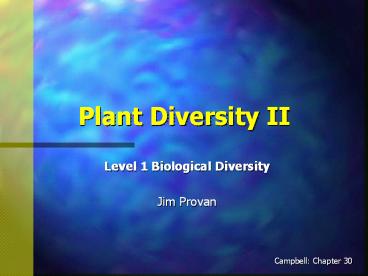Plant Diversity II PowerPoint PPT Presentation
1 / 18
Title: Plant Diversity II
1
Plant Diversity II
- Level 1 Biological Diversity
- Jim Provan
Campbell Chapter 30
2
Reproductive adaptations of seed plants
- Three life cycle modifications led to the success
of terrestrial plants - Reduction of the gametophyte retained in the
moist reproductive tissue of the sporphyte - Origin of the seed
- Zygotes developed into embryos packaged with a
food supply within a protected seed coat - Seeds replaced spores as the main means of
dispersal - Evolution of pollen plants were no longer tied
to water for fertilisation
3
Reduction of gametophytes in seed plants
4
In seed plants, the seed replaced the spore as
the main means of dispersing offspring
- Relatively harsh terrestrial environment
- Bryophytes and seedless vascular plants release
spores - Seeds are more hardy because of their
multicellular nature - Seed is a sporophyte embryo and a food supply
surrounded by a protective coat - All seed plants are heterosporous
- Development of seed associated with
megasporangia - Seed plant megasporangia are fleshy structure
called nucelli - Additional tissues (integuments) surround
megasporangium - Resulting structure is called an ovule
- Female gametophyte develops in wall of megaspore,
is fertilised (embryo) and resulting ovule
develops into a seed
5
From ovule to seed
6
Pollen became the vehicle for sperm cells in seed
plants
- Microspores develop into pollen grains which
mature to form the male gametophytes of seed
plants - Pollen grains coated with a resistant polymer,
sporopollenin - Can be carried away by wind or animals (e.g.
bees) following release from microsporangia - A pollen grain near an ovule will extend a tube
and discharge sperm cells into the female
gametophyte within the ovule - In some gymnosperms, sperm are flagellated
(ancestral) - Other gymnosperms (including conifers) and
angiosperms do not have flagellated sperm cells
7
Gymnosperms
- Descended from Devonian progymnosperms
- Seedless
- Seeds evolved late Devonian
- Climatic changes during Permian led to lycopods,
horsetails and ferns being replaced by conifers
and cycads - Lack enclosed chambers (ovaries) in which seeds
develop
8
Four divisions of extant gymnosperms
9
Conifers are the largest division of gymnosperms
- Mostly evergreens e.g. pines, firs, spruces,
larches, yews, cypresses etc. - Include the tallest, largest and oldest living
organisms - Needle-shaped leaves adapted to dry conditions
- Thick cuticle covers leaf
- Stomata in pits, reducing water loss
- Megaphylls cf. other leaves
10
The life cycle of a pine
11
Angiosperms
12
Angiosperms (flowering plants)
- Flowering plants are the most widespread and
diverse (250,000 species) - Only one division (Anthophyta), with two classes
- Monocotyledons
- Dicotyledons
- Less dependent on wind pollination - use insects
and animals
13
Evolution of vascular tissue in angiosperms
- Conifers have water-conducting cells called
tracheids
- Angiosperms have vessel elements
- More specialised for transport
- Less specialised for support
- Xylem reinforced by fibres
- Specialised for support - thick lignified wall
- Evolved in conifers (conifers lack vessel
elements)
14
The flower is the defining reproductive
adaptation of angiosperms
- Sepals sterile, enclose bud
- Petals sterile, attract pollinators
- Stamen produces pollen
- Carpel evolved from seed-bearing leaf that
became rolled into a tube - Stigma sticky structure that receives pollen
- Ovary protects ovules, which develop into seeds
after fertilisation
15
Fruits help disperse the seeds of angiosperms
- Fruits are ripened ovaries that protect dormant
seed and aids in its dispersal - Modifications of fruits that aid dispersal
include - Seeds within fruits that are shaped like kites or
propellors (e.g. maple) - Burr-like fruit that cling to animal fur
- Edible fruit - tough seeds pass through digestive
tract
16
Life cycle of an angiosperm
17
Angiosperms and animals shaped one anothers
evolution
- Coevolution reciprocal evolutionary responses
among two or more interacting species - Coevolution led to diversity of flowers
- Flower-specific pollinators
- Usually adapted for types of pollinators
- Attraction of ripening fruits
- Soft, fragrant and sugary
- Attractive change of colour
18
Plants transformed the atmosphere and the climate
- Plants decreased atmospheric carbon dioxide,
resulting in global cooling
- Cooler environment made terrestrial life more
habitable for other organisms

